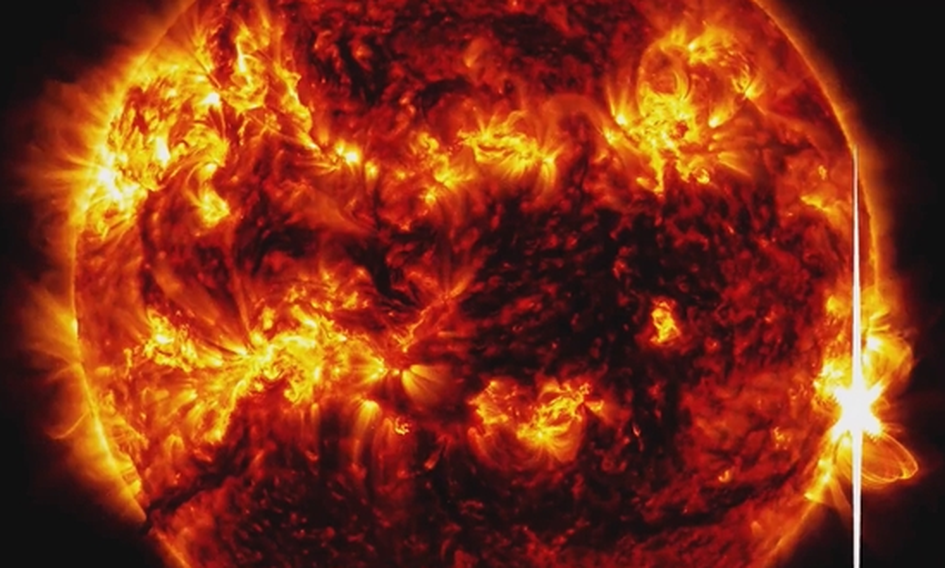New insights into the Sun's corona emerge from the first successful detailed magnetic field measurements – crucial for understanding solar eruptions
Peking University team achieves milestone in solar physics by mapping the coronal magnetic field

The Sun’s corona, its outermost atmospheric layer, holds the key to understanding solar activity, including phenomena like solar flares and space weather events. For decades, scientists have grappled with the challenge of measuring the Sun’s coronal magnetic field, as this field drives much of the energy that leads to solar eruptions.
Now, in a groundbreaking achievement, Professor Tian Hui's research team from Peking University, in collaboration with international experts, has made the first conventional measurements of the global coronal magnetic field. Their findings, published in the journal Science (Volume 386, No 6717), offer new insights into the Sun’s magnetic activity over a period of eight months.
The Sun’s magnetic field is responsible for storing and releasing energy, which heats the plasma in the corona and triggers solar eruptions. These eruptions, in turn, can have significant impacts on space weather, potentially affecting satellite operations, GPS systems, and even human spaceflight. However, due to the relatively weak nature of the coronal magnetic field compared to the magnetic field on the Sun’s surface (the photosphere), measuring this field has proven to be a significant challenge.
The importance of coronal magnetic field measurements
As the Sun rotates, there are variations in the magnetic fields and the ability to regularly monitor the Sun’s coronal magnetic field will improve our understanding of solar eruptions and help protect high-tech systems on Earth and in space.
Over the years, there have been routine measurements of the photospheric magnetic field, but the coronal field has remained elusive. This limitation has impeded scientists' ability to fully understand the three-dimensional magnetic field structure and the dynamic processes that occur in the Sun’s atmosphere.
In 2020, Tian Hui's team developed a method called “two-dimensional coronal shocks,” which enabled the first measurements of the global distribution of the coronal magnetic field. This was a major milestone, marking a crucial step towards the goal of routine coronal magnetic field measurements.
More recently, Tian's team refined this method further, allowing them to track magnetohydrodynamic shear waves in the corona with greater precision. This made it possible to diagnose the distribution of coronal density and, as a result, determine both the strength and direction of the magnetic field.
Are you a pro? Subscribe to our newsletter
Sign up to the TechRadar Pro newsletter to get all the top news, opinion, features and guidance your business needs to succeed!
Using the Upgraded Coronal Multi-Channel Polarimeter (UCoMP), the research team conducted detailed observations of the Sun’s corona from February to October 2022. Over this eight-month period, they collected 114 magnetograms, or magnetic field images, which allowed them to observe the evolution of the coronal magnetic field at different altitudes and latitudes across multiple solar rotations. The magnetic field strength measured between 1.05 and 1.60 solar radii and varied from less than 1 gauss to around 20 gauss.
With these measurements, they were able to create a global map of the magnetic field intensity in the Sun’s corona. This map revealed how the magnetic field evolves over time and across different regions of the Sun.
When compared to the predictions of the most advanced global coronal models—such as the one developed by Predictive Science, a U.S.-based company—the team found that their observational data closely matched the model’s predictions in mid- and low-latitude regions. However, they noted larger discrepancies in high-latitude regions and active areas of the Sun.
These findings are critical for improving current models of the Sun’s magnetic activity and understanding the dynamics of solar eruptions. As lead author Yang Zihao explains, the team's observations provide a key foundation for refining and optimizing coronal models, which could eventually lead to more accurate predictions of solar eruptions and their potential impact on Earth’s space environment.
This study marks a shift in solar physics, as the field enters a new era of routine coronal magnetic field measurements.
According to Tian Hui, this achievement is just the beginning. While their current methods allow for the measurement of the magnetic field at the edge of the solar disk, the next goal is to develop techniques that will enable a complete measurement of the entire coronal magnetic field, including the solar disk itself. This will require the integration of other measurement methods and tools, but it represents a critical objective for the solar physics community in the coming decades.
Via Science
More from TechRadar Pro
- These are the best cloud computing services
- Scientists want to add broadband technology to your brain
- Universities worldwide compete to become dominant force in 6G

Efosa has been writing about technology for over 7 years, initially driven by curiosity but now fueled by a strong passion for the field. He holds both a Master's and a PhD in sciences, which provided him with a solid foundation in analytical thinking. Efosa developed a keen interest in technology policy, specifically exploring the intersection of privacy, security, and politics. His research delves into how technological advancements influence regulatory frameworks and societal norms, particularly concerning data protection and cybersecurity. Upon joining TechRadar Pro, in addition to privacy and technology policy, he is also focused on B2B security products. Efosa can be contacted at this email: udinmwenefosa@gmail.com